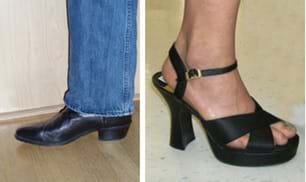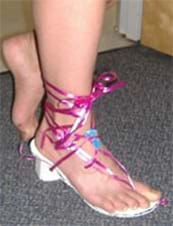Quick Look
Grade Level: Middle school
Time Required: 1 hour
Expendable Cost: US $1.00
Group Size: 3
Subject Areas: Science and Technology
Introduction
Bolded words are vocabulary and concepts to highlight with students during the activity.
There are thousands of different types of shoes and just as many engineers working to develop new styles and improve existing designs. Engineers consider many variables when designing shoes: the material type for durability and function, anticipated shoe stresses and strains, the health and safety of the shoe wearer, and the shoe's aesthetics, among others. Engineers often work with podiatrists (foot doctors) to design high-tech shoes that are safe, comfortable and stylish. Mechanical engineers apply principles of physics to analyze, design and manufacture mechanical systems, including new shoes. Materials engineers—specialists in the structure of materials and their properties—select and design the best combination of materials for shoes. 
Supplies
Each group needs:
- 1 utility knife/box cutter
- 1-2 markers (any color)
- 1 ruler
- assorted sizes of foam core board
- assorted colors of ribbon
- hot glue gun/sticks
- duct tape (shared)
- 2 sheets of blank paper
- 1-2 pairs of scissors
Subscribe
Get the inside scoop on all things TeachEngineering such as new site features, curriculum updates, video releases, and more by signing up for our newsletter!Procedure
Procedures Overview
Students design and build high-heeled shoes using simple materials. Then, they test and redesign their shoes to provide maximum comfort and stability for the wearer.
Procedure
- Organize the students into groups of three.
- In their groups, have students discuss for 3-4 minutes the properties that make up a good shoe (that is, flexible, comfortable, stylish, durable, etc.).
- Then, lead a brief class discussion on the same topic, specifically discussing stability, what the shoe will be used for, how durable it needs to be, its comfort, etc.
- Tell students that they will be making high-heeled shoes from the materials listed above (show supplies to students). They need to make a pair of shoes to fit one member of their team, then that member will complete a "shoe walk" through an obstacle course.
- Have student groups brainstorm ideas for their shoes (10 minutes), sketching out viable ideas on paper. The shoes should meet the following requirements:
- At least a two-inch heel (at the highest point).
- Must stay on the foot without being held on by the other foot or a hand.
- Must be a matching pair (left foot and right foot).

Shoes under stress!
- After each group has agreed on a shoe design, have students check their ideas with a leader before they begin building. Make sure they have a plan for making the shoe fit, holding it on, making sure it is the right size, keeping the heel attached, etc.
Please note: for the next step, the instructor(s) should supervise the use of the hot glue guns and utility knives at all times. If necessary, cut/glue the material for students.
- After designs are approved, students may begin to build their shoes. Allow 15 minutes for building.
- Once all students have fabricated their shoes, have them complete a short obstacle course—walk around the classroom, step up on books, softly jump, etc.—to see which shoes hold up best. Allow 5-7 minutes for the "shoe walk" through an obstacle course.
- After the obstacle course is completed by all groups, give students a chance to improve their shoe designs, addressing any flaws they noticed in the testing. As time permits, have students continue to test their shoes as they see fit.
Wrap Up - Thought Questions
- Which aspects of your design worked well? Why?
- Which aspect did not work well? Why not?
- What other supplies could you have used to build your shoes? How would you have used these additional materials?
More Curriculum Like This

Students use the engineering design process to solve a real-world problem—shoe engineering! Working in small teams, they design, build and test a pair of wearable platform or high-heeled shoes, taking into consideration the stress and strain forces that it will encounter from the shoe wearer.

Students explore the basic physics behind walking, and the design and engineering of shoes to accommodate different gaits. They are introduced to pressure, force and impulse as they relate to shoes, walking and running. Students learn about the mechanics of walking, shoe design and common gait misal...

Student teams design and build shoe prototypes that convert between high heels and athletic shoes. They apply their knowledge about the mechanics of walking and running as well as shoe design (as learned in the associated lesson) to design a multifunctional shoe that is both fashionable and function...
Copyright
© 2007 by Regents of the University of ColoradoLast modified: May 12, 2022







User Comments & Tips